Berg J.M., Tymoczko J.L., Stryer L. Biochemistry
Подождите немного. Документ загружается.

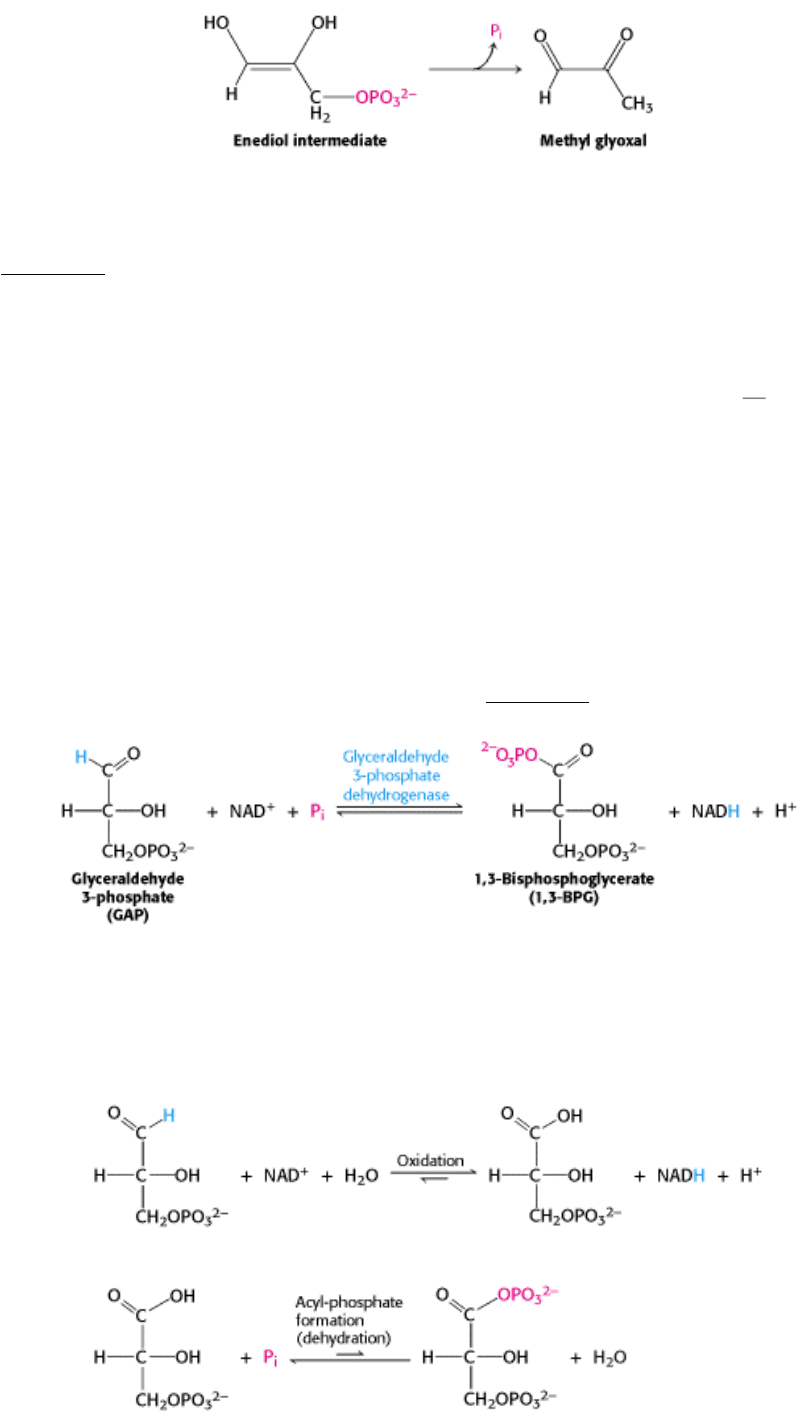
In solution, this physiologically useless reaction is 100 times as fast as isomerization. Hence, TIM must prevent the
enediol from leaving the enzyme. This labile intermediate is trapped in the active site by the movement of a loop of 10
residues (see Figure 16.5). This loop serves as a lid on the active site, shutting it when the enediol is present and
reopening it when isomerization is completed. We see here a striking example not only of catalytic perfection, but also of
the acceleration of a desirable reaction so that it takes place much faster than an undesirable alternative reaction. Thus,
two molecules of glyceraldehyde 3-phosphate are formed from one molecule of fructose 1,6-bisphosphate by the
sequential action of aldolase and triose phosphate isomerase. The economy of metabolism is evident in this reaction
sequence. The isomerase funnels dihydroxyacetone phosphate into the main glycolytic pathway a separate set of
reactions is not needed.
16.1.5. Energy Transformation: Phosphorylation Is Coupled to the Oxidation of
Glyceraldehyde 3-phosphate by a Thioester Intermediate
The preceding steps in glycolysis have transformed one molecule of glucose into two molecules of glyceraldehyde 3-
phosphate, but no energy has yet been extracted. On the contrary, thus far two molecules of ATP have been invested. We
come now to a series of steps that harvest some of the energy contained in glyceraldehyde 3-phosphate. The initial
reaction in this sequence is the conversion of glyceraldehyde 3-phosphate into 1,3-bisphosphoglycerate (1,3-BPG), a
reaction catalyzed by glyceraldehyde 3-phosphate dehydrogenase (Figure 16.7).
1,3-Bisphosphoglycerate is an acyl phosphate. Such compounds have a high phosphoryl-transfer potential; one of its
phosphoryl groups is transferred to ADP in the next step in glycolysis. The reaction catalyzed by glyceraldehyde 3-
phosphate dehydrogenase is really the sum of two processes: the oxidation of the aldehyde to a carboxylic acid by NAD
+
and the joining of the carboxylic acid and orthophosphate to form the acyl-phosphate product.
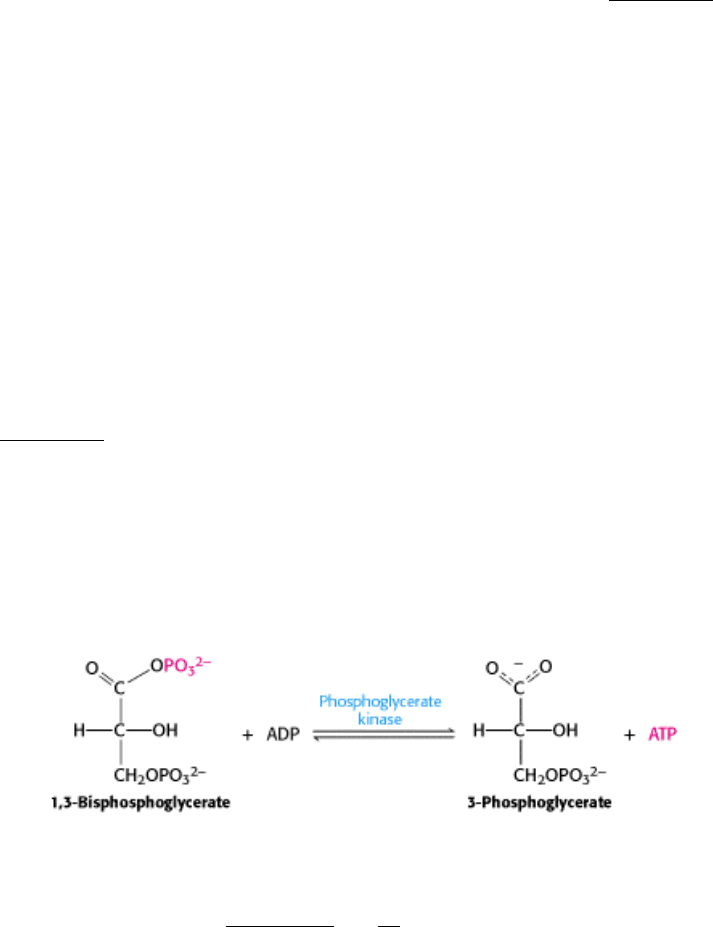
The first reaction is quite thermodynamically favorable with a standard free-energy change, ∆ G°´, of approximately -12
kcal mol
-1
(-50 kJ mol
-1
), whereas the second reaction is quite unfavorable with a standard free-energy change of the
same magnitude but the opposite sign. If these two reactions simply took place in succession, the second reaction would
have a very large activation energy and thus not take place at a biologically significant rate. These two processes must be
coupled so that the favorable aldehyde oxidation can be used to drive the formation of the acyl phosphate. How are these
reactions coupled? The key is an intermediate, formed as a result of the aldehyde oxidation, that is higher in free energy
than the free carboxylic acid is. This intermediate reacts with orthophosphate to form the acyl-phosphate product.
Let us consider the mechanism of glyceraldehyde 3-phosphate dehydrogenase in detail (Figure 16.8). In step 1, the
aldehyde substrate reacts with the sulfhydryl group of cysteine 149 on the enzyme to form a hemithioacetal. Step 2 is the
transfer of a hydride ion to a molecule of NAD
+
that is tightly bound to the enzyme and is adjacent to the cysteine
residue. This reaction is favored by the deprotonation of the hemithioacetal by histidine 176. The products of this
reaction are the reduced coenzyme NADH and a thioester intermediate. This thioester intermediate has a free energy
close to that of the reactants. In step 3, orthophosphate attacks the thioester to form 1,3-BPG and free the cysteine
residue. This displacement occurs only after the NADH formed from the aldehyde oxidation has left the enzyme and
been replaced by a second NAD
+
. The positive charge on the NAD
+
may help polarize the thioester intermediate to
facilitate the attack by orthophosphate.
This example illustrates the essence of energy transformations and of metabolism itself: energy released by carbon
oxidation is converted into high phosphoryl-transfer potential. The favorable oxidation and unfavorable phosphorylation
reactions are coupled by the thioester intermediate, which preserves much of the free energy released in the oxidation
reaction. We see here the use of a covalent enzyme-bound intermediate as a mechanism of energy coupling. A free-
energy profile of the glyceraldehyde 3-phosphate dehydrogenase reaction, compared with a hypothetical process in
which the reaction proceeds without this intermediate, reveals how this intermediate allows a favorable process to drive
an unfavorable one (Figure 16.9).
16.1.6. The Formation of ATP from 1,3-Bisphosphoglycerate
The final stage in glycolysis is the generation of ATP from the phosphorylated three-carbon metabolites of glucose.
Phosphoglycerate kinase catalyzes the transfer of the phosphoryl group from the acyl phosphate of 1,3-
bisphosphoglycerate to ADP. ATP and 3-phosphoglycerate are the products.
The formation of ATP in this manner is referred to as substrate-level phosphorylation because the phosphate donor, 1,3-
BPG, is a substrate with high phosphoryl-transfer potential. We will contrast this manner of ATP formation with that in
which ATP is formed from ionic gradients in Chapters 18 and 19.
Thus, the outcomes of the reactions catalyzed by glyceraldehyde 3-phosphate dehydrogenase and phosphoglycerate
kinase are:
1. Glyceraldehyde 3-phosphate, an aldehyde, is oxidized to 3-phosphoglycerate, a carboxylic acid.
2. NAD
+
is concomitantly reduced to NADH.
3. ATP is formed from P
i
and ADP at the expense of carbon oxidation energy.
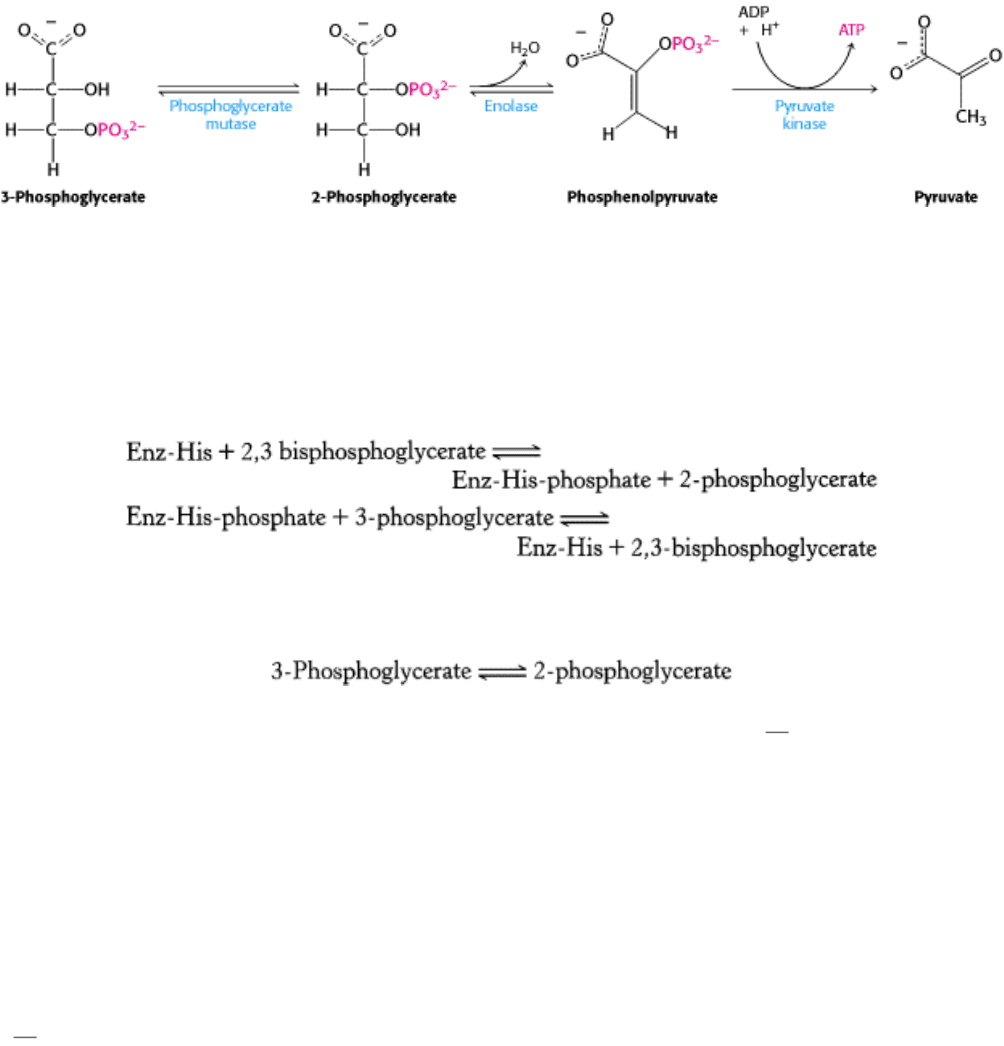
Keep in mind that, because of the actions of aldolase and triose phosphate isomerase, two molecules of glyceraldehyde 3-
phosphate were formed and hence two molecules of ATP were generated. These ATP molecules make up for the two
molecules of ATP consumed in the first stage of glycolysis.
16.1.7. The Generation of Additional ATP and the Formation of Pyruvate
In the remaining steps of glycolysis, 3-phosphoglycerate is converted into pyruvate with the concomitant conversion of
ADP into ATP.
The first reaction is a rearrangement. The position of the phosphoryl group shifts in the conversion of 3-
phosphoglycerate into 2-phosphoglycerate, a reaction catalyzed by phosphoglycerate mutase. In general, a mutase is an
enzyme that catalyzes the intramolecular shift of a chemical group, such as a phosphoryl group. The phosphoglycerate
mutase reaction has an interesting mechanism: the phosphoryl group is not simply moved from one carbon to another.
This enzyme requires catalytic amounts of 2,3-bisphosphoglycerate to maintain an active-site histidine residue in a
phosphorylated form.
The sum of these reactions yields the mutase reaction:
Examination of the first partial reaction reveals that the mutase functions as a phosphatase
it converts 2,3-
bisphosphoglycerate into 2-phosphoglycerate. However, the phosphoryl group remains linked to the enzyme. This
phosphoryl group is then transferred to 3-phosphoglycerate to reform 2,3-bisphosphoglycerate.
In the next reaction, an enol is formed by the dehydration of 2-phosphoglycerate. Enolase catalyzes the formation of
phosphoenolpyruvate (PEP). This dehydration markedly elevates the transfer potential of the phosphoryl group. An enol
phosphate has a high phosphoryl-transfer potential, whereas the phosphate ester, such as 2-phosphoglycerate, of an
ordinary alcohol has a low one. The ∆ G°´ of the hydrolysis of a phosphate ester of an ordinary alcohol is -3 kcal mol
-1
(-
13 kJ mol
-1
), whereas that of phosphoenolpyruvate is -14.8 kcal mol
-1
(- 62 kJ mol
-1
). Why does phosphoenolpyruvate
have such a high phosphoryl-transfer potential? The phosphoryl group traps the molecule in its unstable enol form.
When the phosphoryl group has been donated to ATP, the enol undergoes a conversion into the more stable
ketone namely, pyruvate.
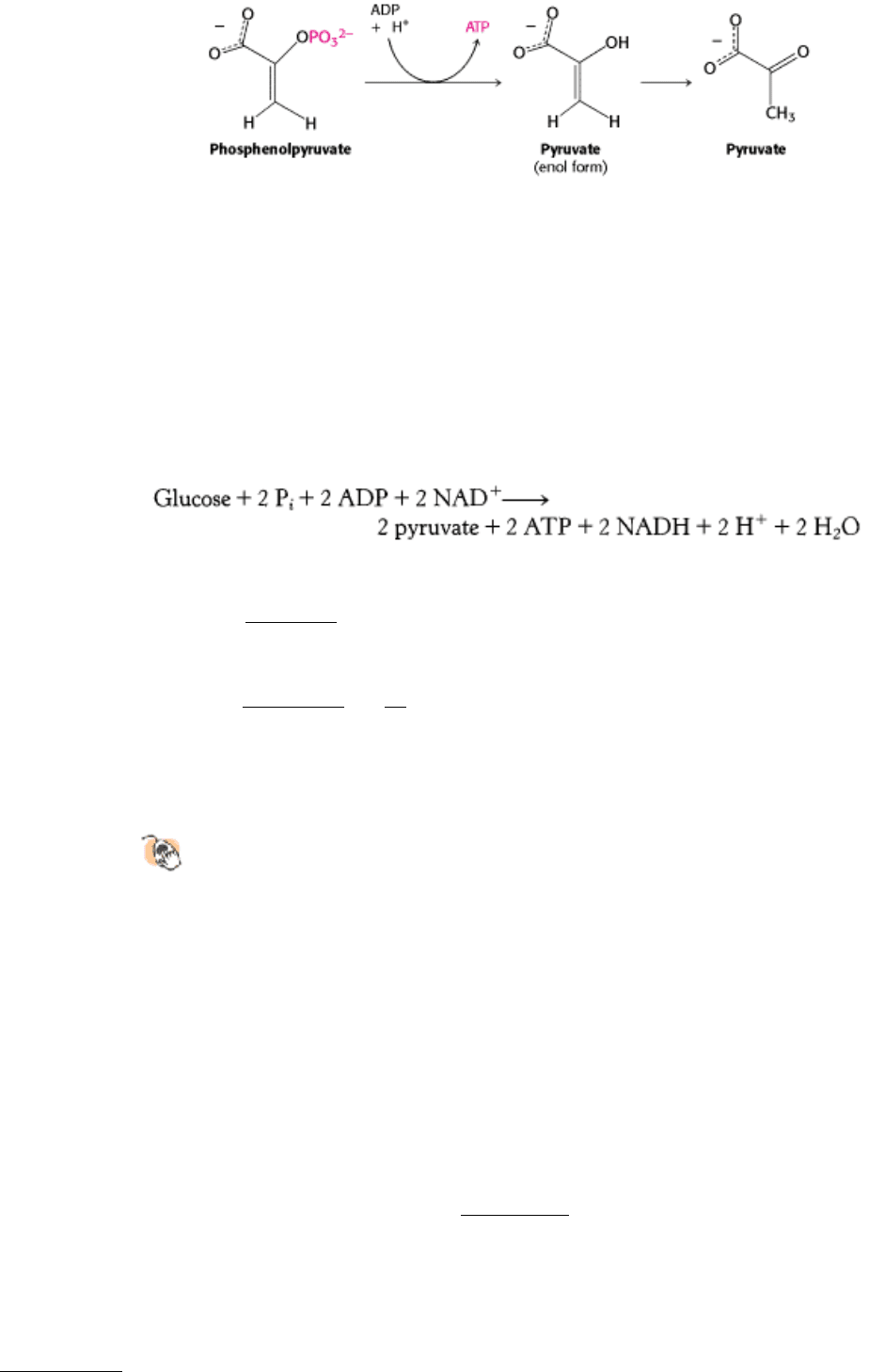
Thus, the high phosphoryl-transfer potential of phosphoenolpyruvate arises primarily from the large driving force of the
subsequent enol-ketone conversion. Hence, pyruvate is formed, and ATP is generated concomitantly. The virtually
irreversible transfer of a phosphoryl group from phosphoenolpyruvate to ADP is catalyzed by pyruvate kinase. Because
the molecules of ATP used in forming fructose 1,6-bisphosphate have already been regenerated, the two molecules of
ATP generated from phosphoenolpyruvate are "profit."
16.1.8. Energy Yield in the Conversion of Glucose into Pyruvate
The net reaction in the transformation of glucose into pyruvate is:
Thus, two molecules of ATP are generated in the conversion of glucose into two molecules of pyruvate. The reactions of
glycolysis are summarized in Table 16.3.
Note that the energy released in the anaerobic conversion of glucose into two molecules of pyruvate is -21 kcal mol
-1
(-
88 kJ mol
-1
). We shall see in Chapters 17 and 18 how much more energy can be released from glucose in the presence of
oxygen.
Conceptual Insights, Energetics of Glucose Metabolism. See the section on
the energetics of glycolysis in the conceptual insights module for a graphical
representation of free energy differences among glycolytic metabolites, and
how these differences are used to drive ATP and NADH synthesis in coupled
reactions.
16.1.9. Maintaining Redox Balance: The Diverse Fates of Pyruvate
The conversion of glucose into two molecules of pyruvate has resulted in the net synthesis of ATP. However, an energy-
converting pathway that stopped at pyruvate would not proceed for long, because redox balance has not been maintained.
As we have seen, the activity of glyceraldehyde 3-phosphate dehydrogenase, in addition to generating a compound with
high phosphoryl-transfer potential, of necessity leads to the reduction of NAD
+
to NADH. There are limited amounts of
NAD
+
in the cell, which is derived from the vitamin niacin, a dietary requirement in human beings. Consequently, NAD
+
must be regenerated for glycolysis to proceed. Thus, the final process in the pathway is the regeneration of NAD
+
through the metabolism of pyruvate. The sequence of reactions from glucose to pyruvate is similar in most organisms
and most types of cells. In contrast, the fate of pyruvate is variable. Three reactions of pyruvate are of prime importance:
conversion into ethanol, lactic acid, or carbon dioxide (Figure 16.10).
1. Ethanol is formed from pyruvate in yeast and several other microorganisms. The first step is the decarboxylation of
pyruvate. This reaction is catalyzed by pyruvate decarboxylase, which requires the coenzyme thiamine pyrophosphate.
This coenzyme, derived from the vitamin thiamine (B
1
), also participates in reactions catalyzed by other enzymes
(Section 17.1.1). The second step is the reduction of acetaldehyde to ethanol by NADH, in a reaction catalyzed by
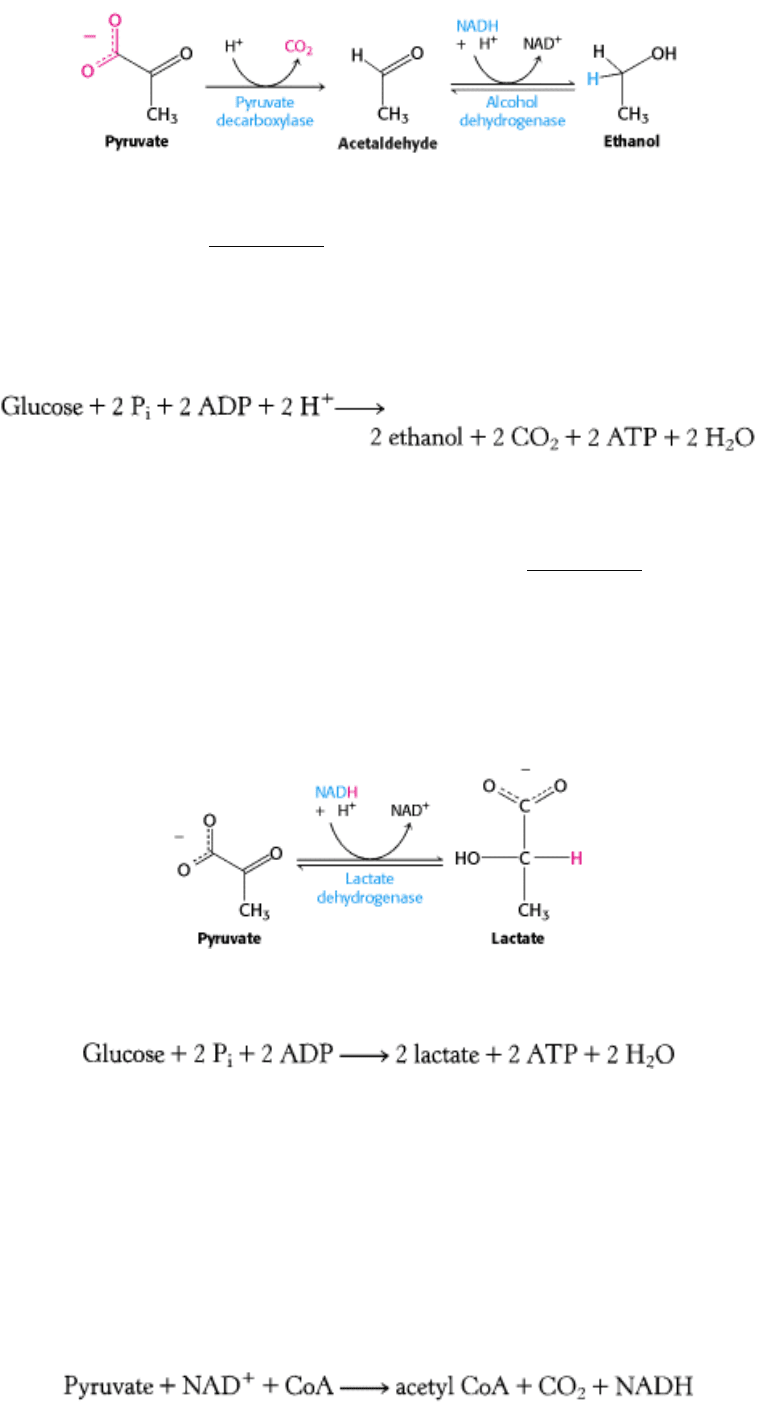
alcohol dehydrogenase. This process regenerates NAD
+
.
The active site of alcohol dehydrogenase contains a zinc ion that is coordinated to the sulfur atoms of two cysteine
residues and a nitrogen atom of histidine (Figure 16.11). This zinc ion polarizes the carbonyl group of the substrate to
favor the transfer of a hydride from NADH.
The conversion of glucose into ethanol is an example of alcoholic fermentation. The net result of this anaerobic process
is:
Note that NAD
+
and NADH do not appear in this equation, even though they are crucial for the overall process. NADH
generated by the oxidation of glyceraldehyde 3-phosphate is consumed in the reduction of acetaldehyde to ethanol. Thus,
there is no net oxidation-reduction in the conversion of glucose into ethanol (Figure 16.12). The ethanol formed in
alcoholic fermentation provides a key ingredient for brewing and winemaking.
2. Lactate is formed from pyruvate in a variety of microorganisms in a process called lactic acid fermentation. The
reaction also takes place in the cells of higher organisms when the amount of oxygen is limiting, as in muscle during
intense activity. The reduction of pyruvate by NADH to form lactate is catalyzed by lactate dehydrogenase.
The overall reaction in the conversion of glucose into lactate is:
As in alcoholic fermentation, there is no net oxidation-reduction. The NADH formed in the oxidation of glyceraldehyde
3-phosphate is consumed in the reduction of pyruvate. The regeneration of NAD
+
in the reduction of pyruvate to lactate
or ethanol sustains the continued operation of glycolysis under anaerobic conditions.
3. Only a fraction of the energy of glucose is released in its anaerobic conversion into ethanol or lactate. Much more
energy can be extracted aerobically by means of the citric acid cycle and the electron-transport chain. The entry point to
this oxidative pathway is acetyl coenzyme A (acetyl CoA), which is formed inside mitochondria by the oxidative
decarboxylation of pyruvate.
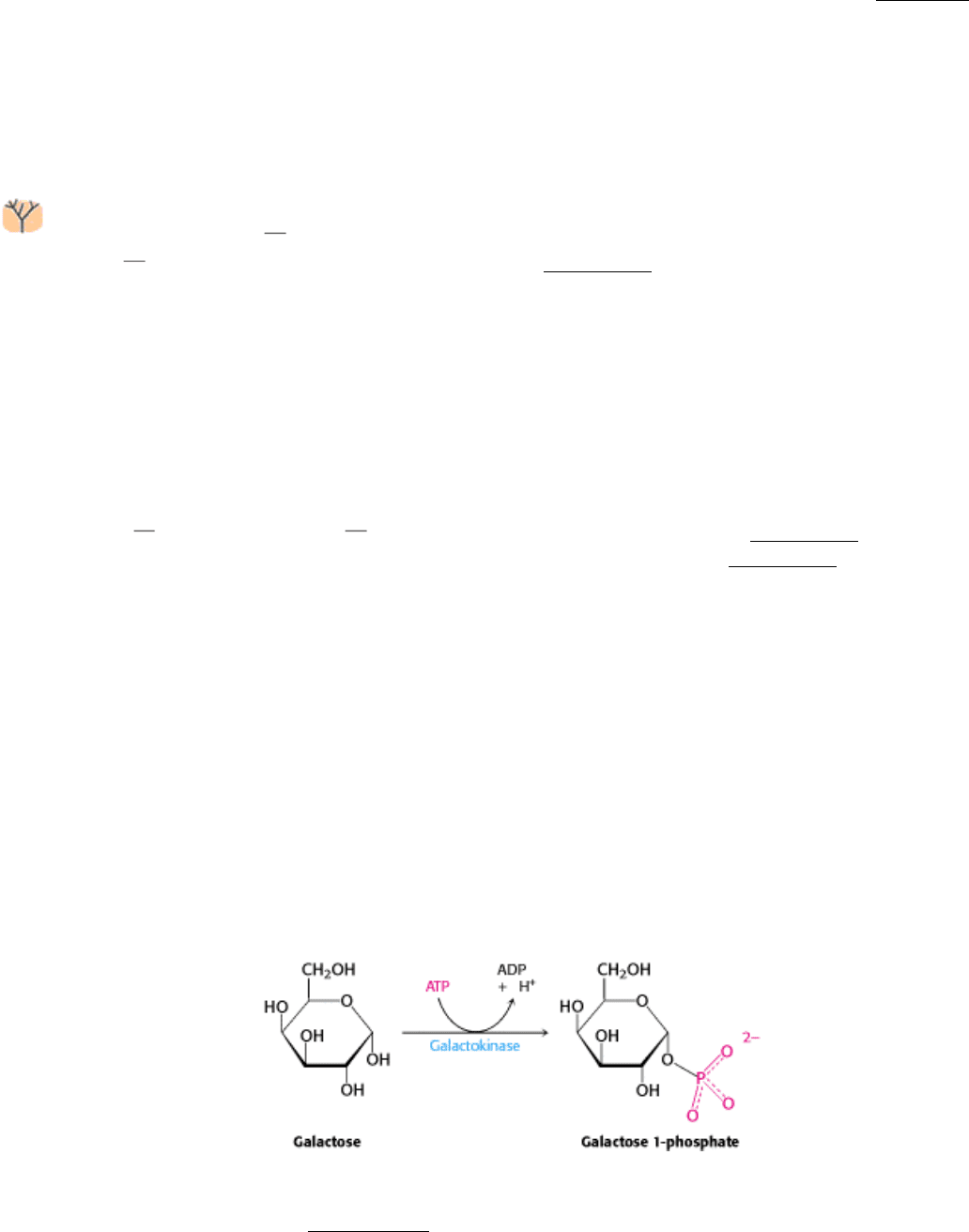
This reaction, which is catalyzed by the pyruvate dehydrogenase complex, will be discussed in detail in Chapter 18. The
NAD
+
required for this reaction and for the oxidation of glyceraldehyde 3-phosphate is regenerated when NADH
ultimately transfers its electrons to O
2
through the electron-transport chain in mitochondria.
16.1.10. The Binding Site for NAD
+
Is Similar in Many Dehydrogenases
Although the enzymes taking part in glycolysis and the subsequent conversion of pyruvate are structurally diverse,
the three dehydrogenases glyceraldehyde 3-phosphate dehydrogenase, alcohol dehydrogenase, and lactate
dehydrogenase
have in common a domain for NAD
+
binding (Figure 16.13). This nucleotide-binding region is made
up of four α helices and a sheet of six parallel β strands. Moreover, in all cases, the bound NAD
+
displays nearly the
same conformation. This common structural domain, one of the first recurring structural domains to be discovered, is
often called a Rossmann fold after Michael Rossmann, who first recognized it. This fold likely represents a primordial
dinucleotide-binding domain that recurs in the dehydrogenases of glycolysis and other enzymes because of their descent
from a common ancestor.
16.1.11. The Entry of Fructose and Galactose into Glycolysis
Although glucose is the most widely used monosaccharide, others also are important fuels. Let us consider how two
abundant sugars
fructose and galactose can be funneled into the glycolytic pathway (Figure 16.14). Much of the
ingested fructose is metabolized by the liver, using the fructose 1-phosphate pathway (Figure 16.15). The first step is the
phosphorylation of fructose to fructose 1-phosphate by fructokinase. Fructose 1-phosphate is then split into
glyceraldehyde and dihydroxyacetone phosphate, an intermediate in glycolysis. This aldol cleavage is catalyzed by a
specific fructose 1-phosphate aldolase. Glyceraldehyde is then phosphorylated to glyceralde-hyde 3-phosphate, a
glycolytic intermediate, by triose kinase. Alternatively, fructose can be phosphorylated to fructose 6-phosphate by
hexokinase. However, the affinity of hexokinase for glucose is 20 times as great as it is for fructose. Little fructose 6-
phosphate is formed in the liver because glucose is so much more abundant in this organ. Moreover, glucose, as the
preferred fuel, is also trapped in the muscle by the hexokinase reaction. Because liver and muscle phosphorylate glucose
rather than fructose, adipose tissue is exposed to more fructose than glucose. Hence, the formation of fructose 6-
phosphate is not competitively inhibited to a biologically significant extent, and most of the fructose in adipose tissue is
metabolized through fructose 6-phosphate.
There are no catabolic pathways to metabolize galactose, so the strategy is to convert galactose into a metabolite of
glucose. Galactose is converted into glucose 6-phosphate in four steps. The first reaction in the galactose-glucose
interconversion pathway is the phosphorylation of galactose to galactose 1-phosphate by galactokinase.
Galactose 1-phosphate then acquires a uridyl group from uridine diphosphate glucose (UDP-glucose), an intermediate in
the synthesis of glycosidic linkages (Section 21.4.2).
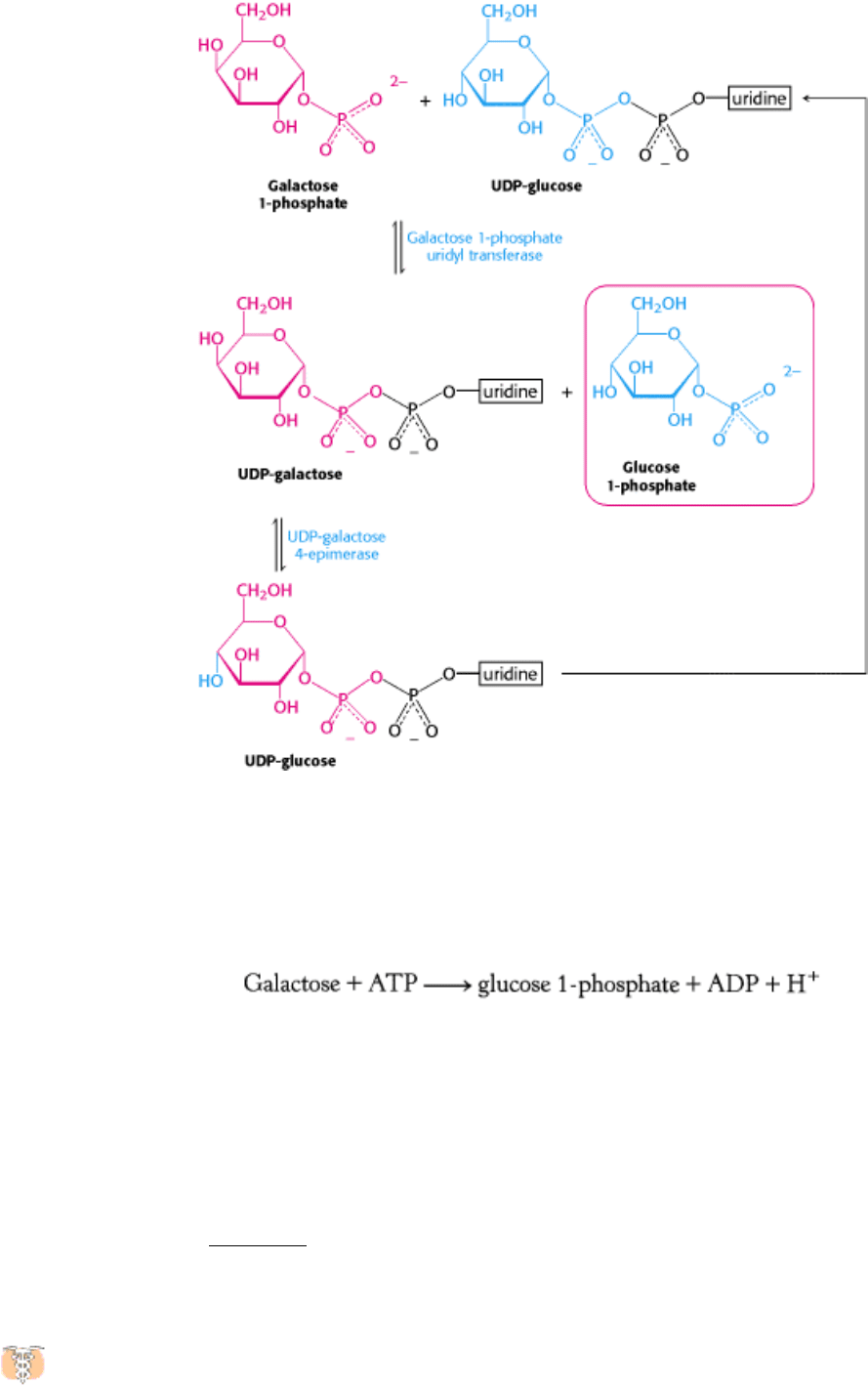
The products of this reaction, which is catalyzed by galactose 1-phosphate uridyl transferase, are UDP-galactose and
glucose 1-phosphate. The galactose moiety of UDP-galactose is then epimerized to glucose. The configuration of the
hydroxyl group at carbon 4 is inverted by UDP-galactose 4-epimerase.
The sum of the reactions catalyzed by galactokinase, the transferase, and the epimerase is:
Note that UDP-glucose is not consumed in the conversion of galactose into glucose, because it is regenerated from UDP-
galactose by the epimerase. This reaction is reversible, and the product of the reverse direction also is important. The
conversion of UDP-glucose into UDP-galactose is essential for the synthesis of galactosyl residues in complex
polysaccharides and glycoproteins if the amount of galactose in the diet is inadequate to meet these needs.
Finally, glucose 1-phosphate, formed from galactose, is isomerized to glucose 6-phosphate by phosphoglucomutase. We
shall return to this reaction when we consider the synthesis and degradation of glycogen, which proceeds through
glucose 1-phosphate, in Chapter 21.
16.1.12. Many Adults Are Intolerant of Milk Because They Are Deficient in Lactase
Many adults are unable to metabolize the milk sugar lactose and experience gastrointestinal disturbances if they
drink milk. Lactose intolerance, or hypolactasia, is most commonly caused by a deficiency of the enzyme lactase,
which cleaves lactose into glucose and galactose.

"Deficiency" is not quite the appropriate term, because a decrease in lactase is normal during development in all
mammals. As children are weaned and milk becomes less prominent in their diets, lactase activity normally declines to
about 5 to 10% of the level at birth. This decrease is not as pronounced with some groups of people, most notably
Northern Europeans, and people from these groups can continue to ingest milk without gastrointestinal difficulties. With
the appearance of milk-producing domesticated animals, a human being with a genetic alteration endowing high levels of
lactase activity in adulthood would hypothetically have a selective advantage in being able to consume calories from the
readily available milk.
What happens to the lactose in the intestine of a lactase-deficient person? The lactose is a good energy source for
microorganisms in the colon, and they ferment it to lactic acid while also generating methane (CH
4
) and hydrogen gas
(H
2
). The gas produced creates the uncomfortable feeling of gut distention and the annoying problem of flatulence. The
lactic acid produced by the microorganisms is osmotically active and draws water into the intestine, as does any
undigested lactose, resulting in diarrhea. If severe enough, the gas and diarrhea hinder the absorption of other nutrients
such as fats and proteins. The simplest treatment is to avoid the consumption of products containing much lactose.
Alternatively, the enzyme lactase can be ingested with milk products.
16.1.13. Galactose Is Highly Toxic If the Transferase Is Missing
Less common than lactose intolerance are disorders that interfere with the metabolism of galactose. The disruption
of galactose metabolism is referred to as galactosemia. The most common form, called classic galactosemia, is an
inherited deficiency in galactose 1-phosphate uridyl transferase activity. Afflicted infants fail to thrive. They vomit or
have diarrhea after consuming milk, and enlargement of the liver and jaundice are common, sometimes progressing to
cirrhosis. Cataracts will form, and lethargy and retarded mental development also are common. The blood-galactose
level is markedly elevated, and galactose is found in the urine. The absence of the transferase in red blood cells is a
definitive diagnostic criterion.
The most common treatment is to remove galactose (and lactose) from the diet. The enigma of galactosemia is that,
although elimination of galactose from the diet prevents liver disease and cataract development, the majority of patients
still suffer from central nervous system malfunction, most commonly a delayed acquisition of language skills. Females
will also display ovarian failure.
Cataract formation is better understood. A cataract is the clouding of the normally clear lens of the eye. If the transferase
is not active in the lens of the eye, the presence of aldose reductase causes the accumulating galactose to be reduced to
galactitol.

Galactitol is osmotically active, and water will diffuse into the lens, instigating the formation of cataracts. In fact, there is
a high incidence of cataract formation with age in populations that consume substantial amounts of milk into adulthood.
II. Transducing and Storing Energy 16. Glycolysis and Gluconeogenesis 16.1. Glycolysis Is an Energy-Conversion Pathway in Many Organisms
Figure 16.3. Stages of Glycolysis. The glycolytic pathway can be divided into three stages: (1) glucose is trapped and
destabilized; (2) two interconvertible three-carbon molecules are generated by cleavage of six-carbon fructose; and (3)
ATP is generated.

II. Transducing and Storing Energy 16. Glycolysis and Gluconeogenesis 16.1. Glycolysis Is an Energy-Conversion Pathway in Many Organisms
Stage 1 of glycolysis. The three steps of stage 1 begin with the phosphorylation of glucose by hexokinase.
II. Transducing and Storing Energy 16. Glycolysis and Gluconeogenesis 16.1. Glycolysis Is an Energy-Conversion Pathway in Many Organisms
Figure 16.4. Induced Fit in Hexokinase.
As shown in blue, the two lobes of hexokinase are separated in the absence of
glucose. The conformation of hexokinase changes markedly on binding glucose, as shown in red. The two lobes of
the enzyme come together and surround the substrate. [Courtesy of Dr. Thomas Steitz.]
